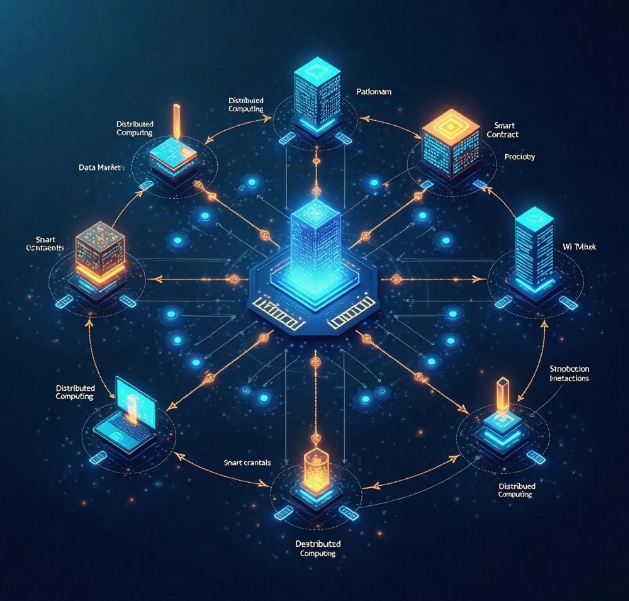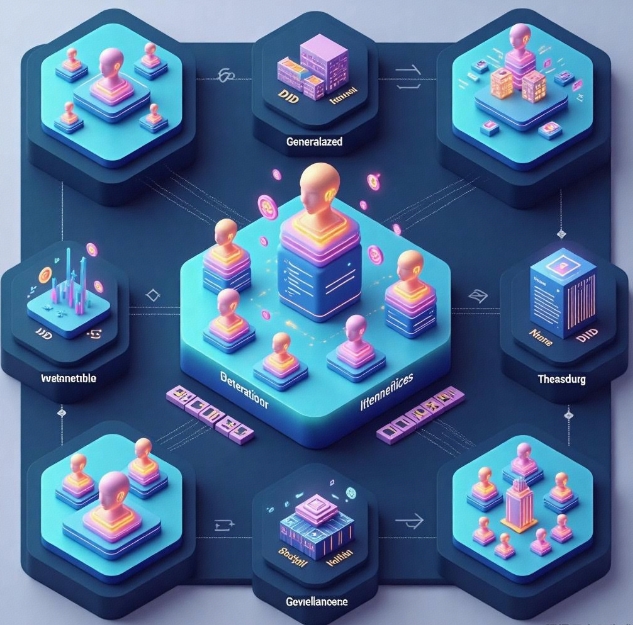Future Web3 development trends: decentralized AI, social interaction and metaverse exploration
- latest articles
- 1.DApp Development & Customization: Merging Diverse Market Needs with User Experience 2.Analysis of the Core Technical System in DApp Project Development 3.How to achieve cross-chain interoperability in Web3 projects? 4.How does the tokenization of points reconstruct the e-commerce ecosystem? 5.How to Set and Track Data Metrics for a Points Mall? 6.What is DApp Development? Core Concepts and Technical Analysis 7.Inventory of commonly used Web3 development tools and usage tips 8.Development of a Distribution System Integrated with Social E-commerce 9.Six Key Steps for Businesses to Build a Points Mall System 10.What is DApp Development? A Comprehensive Guide from Concept to Implementation
- Popular Articles
- 1.Future Trends and Technology Predictions for APP Development in 2025 2.Analysis of the DeFi Ecosystem: How Developers Can Participate in Decentralized Finance Innovation 3.From Zero to One: How PI Mall Revolutionizes the Traditional E-commerce Model 4.DAPP Development | Best Practices for Professional Customization and Rapid Launch 5.Recommended by the Web3 developer community: the most noteworthy forums and resources 6.From Cloud Computing to Computing Power Leasing: Building a Flexible and Scalable Computing Resource Platform 7.How to Develop a Successful Douyin Mini Program: Technical Architecture and Best Practices 8.Shared Bike System APP: The Convenient Choice in the Era of Smart Travel 9.How to Create a Successful Dating App: From Needs Analysis to User Experience Design 10.From Design to Development: The Complete Process of Bringing an APP Idea to Life
Web3 technology is reshaping the internet ecosystem. From decentralized finance (DeFi) to digital identity, and further to NFTs and the metaverse, the development of Web3 has transcended single application layers and is constructing an entirely new digital society. In the future, with the continuous advancement of decentralized artificial intelligence (AI), social networks, and metaverse technologies, the application boundaries of Web3 will further expand, propelling the internet into a more open, autonomous, and immersive era. This article will explore the future development trends of Web3 in the fields of decentralized AI, social networks, and the metaverse, and analyze the opportunities and challenges they may bring.
I. The Rise of Decentralized AI
Artificial intelligence (AI) has always been a core driver of the technology industry, but current mainstream AI models are typically controlled by a few tech giants, such as OpenAI, Google DeepMind, and Meta AI. This centralized model exacerbates issues like data monopolies, algorithmic bias, and privacy breaches. The development of Web3 provides new perspectives and application scenarios for decentralized AI.
1.1 The Concept and Technological Foundation of Decentralized AI
Decentralized AI refers to the use of technologies such as blockchain, distributed computing, and smart contracts to decentralize the development, training, and deployment of AI, thereby eliminating reliance on centralized institutions. Its core technologies include:
Decentralized Computing Networks (e.g., Golem, Fetch.ai): Distribute AI training and inference tasks to global nodes through distributed computing networks to improve computational efficiency and transparency.
Data Markets and Privacy Protection (e.g., Ocean Protocol, Morpheus Labs): Utilize blockchain technology to build data markets, allowing users to share data while protecting privacy, thereby providing broader, high-quality data for AI model training.
Decentralized Machine Learning Frameworks (e.g., SingularityNET, DeepBrain Chain): Enable developers to create, train, and deploy AI models without the need for centralized servers.
1.2 Future Applications of Decentralized AI
Web3 Search Engines: Search engines based on decentralized AI can avoid advertising and algorithmic manipulation, improving the fairness of search results.
Smart Contract AI Auditing: Automatically detect vulnerabilities in smart contracts, reducing the risk of hacker attacks and enhancing Web3 security.
Personalized Recommendation Systems: Through decentralized data processing, users can autonomously decide which data is used for recommendations, rather than being manipulated by centralized platforms.
1.3 Challenges and Opportunities
Challenges: Issues such as computing resource allocation, data privacy protection, and AI compatibility with smart contracts still need to be resolved.
Opportunities: Decentralized AI can enhance the trustworthiness and fairness of the Web3 ecosystem, creating new value spaces for developers and users.
II. The Future of Decentralized Social Networks
With the development of social media, issues of data privacy and information monopolies have gradually emerged. Incidents of user data misuse on centralized social platforms like Facebook and Twitter are common, and Web3 technology offers a new decentralized model for social networks.
2.1 Characteristics of Web3 Social Networks
User Data Ownership: Decentralized social platforms allow users to have full control over their data and manage their identities through NFTs or crypto wallets.
Content Creator Incentives: Blockchain-based token economic models (e.g., Lens Protocol) enable content creators to receive direct economic rewards without relying on advertising revenue.
Censorship Resistance: Since data is stored in distributed networks, decentralized social platforms are more resistant to censorship by governments or corporations.
2.2 Representative Web3 Social Platforms
Lens Protocol: A decentralized social network based on the Polygon blockchain, providing users with portable identities and data for their social experiences.
Mastodon: A decentralized social network using a federated architecture, allowing users from different servers to interact with each other.
Farcaster: A decentralized social protocol that allows developers to create permissionless social applications.
2.3 Future Development Trends
On-Chain Social Identities: Users' social identities will be bound to blockchain wallets and decentralized IDs (DIDs), enhancing privacy control and portability.
Rise of SocialFi: The integration of social networks with DeFi, where users can earn tokens through social interactions (e.g., Friend.tech).
AI-Enhanced Social Experiences: AI will be used in decentralized social networks for content recommendations, social bots, smart contract management, and more.
III. The Metaverse: Immersive Experiences in the Web3 Era
The Metaverse is considered the next major transformation of the internet, and Web3 technology will play a central role in it. From decentralized virtual worlds to digital asset trading, Web3 is providing a new underlying architecture for the construction of the metaverse.
3.1 Intersections of Web3 and the Metaverse
NFTs and Digital Asset Ownership: NFTs grant uniqueness to virtual items, allowing users to truly own land, clothing, and props in the metaverse.
Decentralized Identity (DID): Users can use the same on-chain identity across different metaverse worlds without relying on centralized accounts.
Decentralized Governance (DAO): Through DAO governance models, users can collectively manage metaverse communities and economic rules.
3.2 Representative Decentralized Metaverse Projects
Decentraland: An Ethereum-based virtual world where users can purchase land, create content, and engage in transactions.
The Sandbox: A blockchain-based creative gaming platform that allows users to create and trade NFT assets.
Somnium Space: A decentralized metaverse platform supporting VR experiences, offering immersive social and economic activities.
3.3 Future Trends
AI-Driven Smart NPCs and Content Generation: Utilize decentralized AI to create intelligent NPCs, enhancing interactive experiences in the metaverse.
Cross-Metaverse Interoperability: Through blockchain technology, different metaverse worlds will achieve interoperability, allowing users to freely migrate assets and identities.
Integration of Augmented Reality (AR) and Virtual Reality (VR) with Web3: Richer immersive experiences will drive the widespread application of Web3 in the metaverse.
Conclusion
Web3 is driving the internet into a decentralized era, and the integration of decentralized AI, social networks, and the metaverse will bring limitless possibilities to the future digital world. Although challenges such as technical hurdles, user education, and regulatory issues remain, the development trend of Web3 is irreversible. In the future, we will witness a more open, fair, and user-led internet ecosystem, ushering in a new epoch for the digital world.
-

How to achieve cross-chain interoperability in Web3 projects?
With the continuous development of WEB3 technology, Web3 has gradually become an···
-

Inventory of commonly used Web3 development tools and usage tips
With the continuous development of blockchain technology, Web3 has become a hot ···
-

Web3 development trend prediction: analysis of future technology directions and application scenarios
With the gradual development of blockchain technology, the concept of Web3 has m···

 Blockchain
Blockchain












